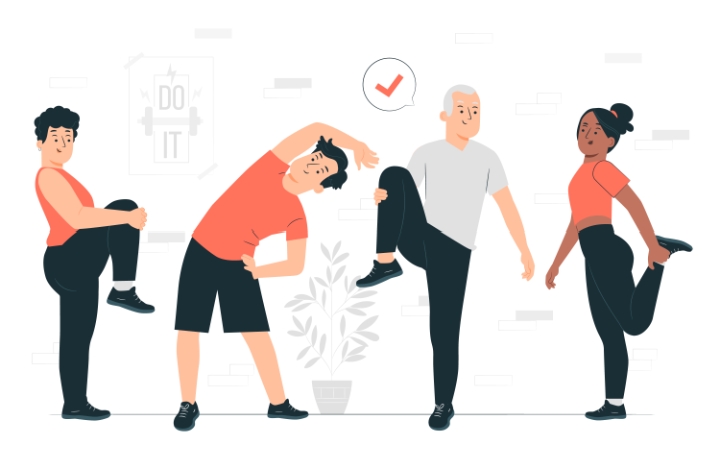Due to our sedentary lifestyle, more often than not, we have heard someone saying to maintain the right posture or stretch our backs to get rid of the curve or the excruciating pain. Since almost all our activities depend on how easily we can move our bodies, stretching on a regular basis does the job.
When tight muscles are the cause, it frequently relieves back pain, stiff necks, and sore knees. Whether you’re doing it for work or fun, it can help counteract too much sitting. If you play cricket, table tennis, run, or ride a bike, the right stretching routine may help you improve your performance.
Stretching can also keep you flexible and active as you age, making it simpler to complete the countless daily tasks that involve walking, climbing stairs, doing household chores, or reaching the topmost shelf of your kitchen.
What are the Reasons to Stretch?
Regular stretching has been shown to enhance movement patterns, prevent or reduce pain in various body regions, and improve posture. This is particularly crucial when it comes to carrying out and maintaining the ability to perform.
For instance, carrying your kids to the car, holding heavy grocery bags, or simply lifting delivery boxes to the storage area. All in all, to maintain quality of life as we age, flexibility is essential.
Flexibility training improves your ability to perform exercises through their full range of motion and with proper technique, which increases the effectiveness of an exercise session in the short term.
Furthermore, stretching may also improve the delivery of blood and nutrients to the muscles, ease muscle tension, and speed up recovery in between workouts.
The “dos” of Stretching
- Make sure the muscles are stretched with adequate warming-up.
- After your training session, stretch again.
- Relax and take deep breaths and hold each stretch.
- Stretch your entire body as part of a routine to prevent postural imbalances.
- Follow the proper technique as described by your physical therapist or physical therapy home exercise software.
The “don’ts” of stretching
- Try to stretch frozen muscles; it will only lead to harm.
- Before your warm-up, stretch.
- You risk overstretching and hurting yourself if you bounce or rock while holding a stretch.
- Hold a stretch for a long period of time.
- Not taking a deep breath.
- Just concentrate on stretching your legs or your upper body.
Just Do It – Right
Although moving straight on to the stretches may be tempting, it is best to consider safety first. These will lower your risk of injury while assisting you in achieving the best flexibility gains possible.
Warming up
Always ensure that first, you warm up. Muscles stretch more readily when they are warm, similar to taffy. It can be as easy as five minutes of swinging arms while marching in place or a few songs of dancing. First steps that work well include warm showers or moist heat packs.
While stretching, unwind
The second crucial aspect of stretching is to remain relaxed. Your range of motion will be restricted by tension, and your muscles won’t stretch as well. You will benefit to a limited extent from flexibility as a result. You will be more relaxed after your workout has ended than before, which translates to greater flexibility gains.
Breathe normally while stretching
Always maintain a calm, relaxed breathing pattern because doing so will ease overall muscular tension and enable you to stretch further. Stretching will be much less effective if you hold your breath because it will tense your whole body.
Retain the stretch
You must hold the stretch for at least half a minute in order to reap the full benefits of stretching. A brief stretch of each muscle has almost no benefits for flexibility. Keep your posture correct while holding the position to avoid over-relaxing and reducing your gains.
No-pain stretching
Stretching should only cause a slight sensation of tension in the stretched muscle. Stretching with pain can result in an injury or overstretched muscles. Never stretch beyond a “comfortable tightness,” and stop immediately if you feel any pain during the stretching process.
Stretching again after a break
While just one stretch for each targeted muscle is very helpful, two stretches for each, separated by a brief break of half a minute, will help you increase your range of motion.
To Sum Up
Regular stretching can improve your mobility and even your quality of life by allowing your body and joints to move more freely.
Ask your doctor for a recommendation to a physical therapist if you need assistance deciding which stretches are most effective for you (especially if you have an injury or medical condition).
Or you can hop on to physical therapy for a home exercise plan and get started with your workout from the comfort of your home.
AUTHOR’S BIO:








